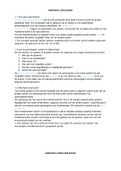Samenvatting
Summary Complete outline of lectures, tutorials and book
- Instelling
- Maastricht University (UM)
Document includes both lecture notes, tutorial questions and answers, as well as any important information from the book! includes the topics: Sources of IHL, NIAC and IAC Status of persons in armed conflict Conduct of hostilities - means and methods of warfare, actors in armed conflict IHL an...
[Meer zien]













